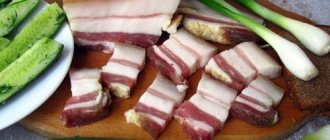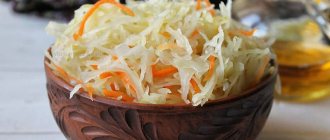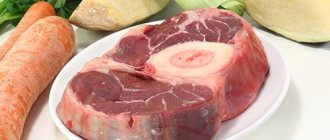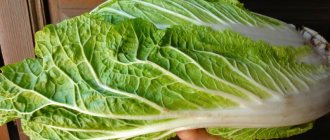Not long ago, this vegetable conquered our vegetable market, becoming a favorite product of most families, even those where cabbage is not liked. This vegetable has tender juicy pulp and a less pronounced (soft) taste; the number of recipes with it is constantly growing, but few know how to properly cut Chinese cabbage. Meanwhile, the taste, appearance and texture of the dish as a whole largely depend on the method and type of cutting, so we decided to devote today’s article to slicing petsai.
Proper cutting of white cabbage for pickling
Sauerkraut is a real art. And here it is important not only the correct salting and sourdough technology, but also the cutting of cabbage. As you know, white cabbage is cut into strips for fermentation, but you need to know which straw is ideal for proper fermentation.
- If the straw is too thin, namely less than two millimeters, then the cabbage will ferment very quickly, before the end of the fermentation process. Such cabbage will be very sour, even pungent, absolutely not crispy and unappetizingly soft and flabby.
- If the straw is very thick, more than six or more millimeters, then the cabbage will not have time to ripen and the salad will turn out tasteless and watery.
- If you cut cabbage with a poorly sharpened blade, then all the juice will be released from the vegetable and as a result the cabbage will turn out tasteless and whitish, without a beautiful amber color.
Ideally, cabbage for pickling should be cut with a knife so that the desired thickness of the straw can be precisely adjusted. The cutting should be uniform, and the straws should not be very long, about 3 cm, and average thickness of 4-5 mm.
In this article you will learn in detail the entire process of properly cutting cabbage for fermentation.
Features of cutting for "Caesar"
Caesar is a classic salad made from lettuce leaves. If desired, you can use a juicier and softer Peking, which will only improve the taste of the dish.
Cutting can be done in large pieces or checkers. If you cut a vegetable into large pieces, only the green part of the leaf is used. If you plan on cutting with a checkerboard, feel free to use the entire head.
The effectiveness of Chinese salad for weight loss
The best varieties of Chinese cabbage
Above, we discussed the benefits of Chinese cabbage for women. Let’s find out in more detail how the use of this leafy plant in the diet affects it.
– Nutritionists’ recommendations for including Chinese cabbage in the diet for weight loss are quite justified: the mentioned salad, as already noted, has a low calorie content and a high concentration of nutrients, which gives the body a deceptive feeling of fullness.
– To digest Chinese salad, the body requires more energy than it receives. This directly indicates that if a sufficient amount of minerals is supplied, the individual will lose extra pounds. Therefore, to maintain an ideal figure and optimal weight, you need to include this product in your daily menu.
– Due to the presence of fiber in this vegetable crop, which enters the digestive tract, a certain barrier is formed in the intestine, due to which slow absorption of carbohydrates and fats occurs.
– One of the components of the chemical structure of the vegetable is citric acid, which will ensure long-term preservation of substances and vitamins necessary for the body. It is enough to add torn leaves of the described plant to a dish of fresh vegetables.
– To burn extra pounds, it is enough to eat salads with Chinese cabbage leaves as dinner. For a faster effect, it is possible to apply a diet based on Chinese cabbage for two weeks: during this period, you should eat boiled meat with fresh leaves of this vegetable crop. Gradually, in order to form a proper nutrition system in order to maintain weight, it is necessary to include Beijing salad in the menu as a mandatory element.
– If you have no desire to stick to a diet, then it will be quite enough to organize a fasting day for yourself twice a month, during which you eat fresh Beijing salad and various vegetables with the addition of a light dressing.
Tips for choosing Beijing salad
Chinese cabbage belongs to a vegetable crop from the Cabbage family; it has a cylindrical stalk and elongated wavy leaves with a thick, rich vein, forming a loose white cob. The leaves come in both white, yellow and green colors. Leaf forms of lettuce are mainly used fresh when cutting salads, and the base itself (head of cabbage) is used in the preparation of marinades, soups, and also for pickling.
Interestingly, lettuce can be stored fresh in the refrigerator for up to three weeks, after wrapping it in plastic wrap. In a cool room (in a cellar, for example) with optimal humidity (~98%), such a plant will last up to several months. Under such storage conditions, it will not lose its unique qualities.
Let’s figure out what criteria will be decisive in the process of selecting a tasty vegetable for consumption:
- All the nutrients and beneficial properties of Chinese cabbage are contained in its leaves, so first of all you should take a closer look at them. The color of the leaves should be deep white; do not choose cabbage with limp leaves of a yellowish tint.
- There should be no moisture on the leaves of Chinese lettuce. If the heads of cabbage are presented in plastic wrap, carefully inspect the wrapper for the presence of condensation, gray spots and black spots, dried edges and yellowness - if any, it means the product has already begun to deteriorate and is unfit for consumption.
- Check the cabbage forks by touch - you should give preference to elastic, dense heads of medium size - this indicates good taste and juiciness of the product.
- The first signs that the lettuce is overripe are the presence of yellowness on the leaves, lethargy, and drying.
- Do not buy forks of Chinese salad wrapped in cling film if you are concerned about the presence of condensation or black spots on it. Such signs indicate that the vegetable is clearly not fresh.
Thus, the main thing you need to pay attention to when choosing a high-quality and fresh specimen of a vegetable crop is the color and condition of the leaves of the head of cabbage itself.
Step-by-step instructions on how to keep vegetables fresh at home
For longer storage of Chinese cabbage, it is best to use the freezer. Thus, fresh vegetables can be preserved in the freezer until the New Year and beyond.
How to prepare:
- First, you need to carefully sort out the cabbage and remove dry, damaged and rotten leaves.
- Then remove hard growths at the base, finely chop, and place the chopped leaves in special containers or plastic bags.
- After this, carefully place the filled containers in the freezer and remove them from there as needed.
- Frozen cabbage must be used immediately, that is, the entire portion at once. Repeated freezing will lead to loss of taste and ruin its appearance.
You can extend the freshness of just purchased Chinese cabbage by placing it on a glassed-in loggia or in the refrigerator.
- To do this, you need to wrap the heads of cabbage in several layers of cling film, each separately.
- To prolong freshness, cabbage packaged in this way must be checked from time to time, missing leaves removed and packed in new cellophane.
It is better to store whole heads of cabbage in the refrigerator in the “freshness zone”, which is located above the freezer. In this case, they will be able to maintain their taste for 15 days. On a glassed-in loggia, cabbage can be stored at a temperature not lower than 0 degrees, packed in the same way as for storage in the refrigerator.
Storing Chinese cabbage in winter in a city apartment is not at all difficult, the main thing is that it initially has a good appearance and is not spoiled. The degree of maturity of the head of cabbage plays a key role in this. It is best to send cabbage for the winter with elastic, dense heads and juicy green leaves.
To store cabbage in an apartment, it is better to take late and mid-late varieties of cabbage: Russian size, Vorozheya, Asten, Knyazhna, Bokal, Kudesnitsa, Polukochannaya. The ripening time for such cabbage varies from 60 to 80 days, and its harvesting, as a rule, occurs in September.
You need to look through the cabbage, which is located on the glassed-in loggia, once every 2 weeks. If spoilage is detected, the missing leaves are completely removed and the used packaging material is replaced with new one. The maximum shelf life of fresh Chinese cabbage under optimal storage conditions is 3 months.
Considering that Chinese cabbage has very beneficial properties, it should be consumed by everyone who has no contraindications to it. What are the benefits and harms for the body, can this vegetable be given to animals, consumed for pancreatitis, gastritis, breastfeeding, and also what is the difference between Peking cabbage and other varieties of cabbage and iceberg lettuce - read on our Internet portal.
Shredding techniques
The benefits of Chinese cabbage for weight loss, dietary recipes and calorie content
The shredder can be thin and large.
- Cabbage is most often chopped thinly, as it becomes soft and is suitable for preparing any dish. The vegetable is cut in half. Cut each half in turn, and it is advisable to chop at a strict angle. Cabbage leaves will be long if cut strictly at an angle. It is advisable to hold the head of cabbage for guaranteed safety.
- Coarsely chopped cabbage will require a long cooking time. The cabbage is initially washed. Then the wilted leaves with the upper part are removed and cut into exactly 2 parts. After this, each half of the cabbage is coarsely chopped.
Both options for slicing Chinese cabbage with a knife are suitable for preparing various tasty, healthy dishes.
Try cutting Chinese cabbage correctly and see how easy this task is. Subscribe to my blog and you will definitely learn a lot more interesting things about cooking!
In Russia, Chinese cabbage became popular relatively recently and has since successfully replaced both its white cabbage relative and various leaf salads. Accordingly, she has several ways to serve it on the table. It should be noted that it is almost always served without any heat treatment, which means that the main subtlety in preparing this dish is the correct cutting.
Longitudinal slicing seems a little unusual at first. To prepare the leaves, you need to separate them, cutting off the hard bottom of the head that holds them together, and put them in cold water for a few minutes. This will help the greens regain their shape and elasticity if they have wilted, and will retain the juiciness of the cabbage in the dish. After removing the leaves from the water, gently pat them dry with a paper towel.
The prepared leaves are placed on a cutting board one on top of the other (2-3 pieces) and cut into thin longitudinal strips. This method is great for fresh vegetable salads, since one strip contains both the juicy white part and the greens. Another “salad” way of serving Chinese cabbage involves the leaves being carefully torn into small pieces by hand or chopped into squares.
If you need to chop the leaves finely, the knife acts predominantly across the leaf, and the result is very reminiscent of shredded white cabbage. You can prepare a head of cabbage for slicing differently than in the first case: just rinse it under the tap, holding it with the base up so that excess water does not accumulate between the leaves. If the degree of washing seems unsatisfactory, the four outer leaves should be discarded: as a rule, underneath there is a perfectly clean and ready-to-use core.
The white part of the leaves is very valuable, therefore, when cutting off the lower fastening part, you need to try not to capture too much. A maximum of five centimeters is removed. The rest of the head of cabbage is divided in half, several longitudinal cuts are made on each half, and then the leaves are finely chopped with short transverse movements.
In order to pickle Chinese cabbage, it is enough to remove the upper spoiled leaves and, without separating the connecting part, cut the head of cabbage lengthwise into four parts. The structure of the plant allows it to absorb brine or marinade quickly and evenly.
Despite the fact that this type of greenery tolerates storage well, you need to ensure that the leaves are not limp or withered. If their color is far from natural pale green, and the head of cabbage does not have elasticity and density, it is better to refrain from purchasing such a product. Good fresh Chinese cabbage contains many vitamins (especially vitamin C) and protein necessary for the normal functioning of the body.
What is incorrect cutting and what are its consequences?
Improper cutting of Chinese cabbage means cutting it into pieces of the wrong size for a particular dish. Simply put, thin shredding of cabbage for Caesar, fine slicing for Kim-Chi - these are all examples of incorrect slicing of Chinese cabbage.
The consequences of this are quite clear - in fact, you end up with a completely different dish, not the one you wanted to prepare. It really can have a completely different taste. For example, if you slice Caesar cabbage too thin, you end up with large, bulky pieces of chicken, halves of cherry tomatoes and a couple of thin strips of Chinese cabbage on your fork. Of course, this will not be the same salad that is served in good restaurants.
So, we told you about the features of correct slicing of Chinese cabbage, about preparing cabbage, what types of slicing there are and for what dishes each of them is used, what equipment is needed for slicing and what the consequences of mistakes in this delicate matter are. We hope our article will be useful to you and your dishes will turn out exactly the way you wanted them to be prepared. We wish you good luck in your cooking!
The variety of dishes made from it can satisfy the needs of even the most demanding gourmet: salted, pickled, fresh, fried, stewed - Chinese cabbage is good in any form.
Korean pickled Chinese cabbage for the winter
15 simple and delicious seaweed salads
Everyone knows carrots in Korean, but few housewives have prepared cabbage in Korean. It turns out just as crispy, appetizing and spicy. The spiciness can be adjusted by the amount of hot pepper and garlic. The dressing for cabbage should be quite spicy, but you can use a little less spicy. The head of cabbage does not need to be finely chopped, which significantly reduces the preparation time for this winter preparation recipe.
Required ingredients:
- Peking - 1.5 kg;
- Garlic – 6 cloves;
- Ground pepper - 4 tablespoons;
- Sugar – a teaspoon;
- Salt – 150 grams;
- Fresh water – 2 l.
Instant pickled Chinese cabbage:
The head of cabbage should be washed, the excess top leaves removed from it and cut into pieces. You don’t have to disassemble the head of cabbage into separate pieces, but simply cut it into 4 parts. The pulp is cut into the necessary pieces just before use; Transfer the pulp to a separate bowl and reserve; Now you should mix boiling water with salt, stir until the crystals are completely dissolved, cool; Pour the cooled solution over the prepared pulp; the solution must completely cover the mass; The mixture is left in the room for 12 hours, only it needs to be covered, for this you can use a small plate, it will hold the pulp under the solution. During the pickling process, you need to stir the pulp several times so that it is completely saturated with the solution; Separately, combine finely chopped garlic, sugar and hot pepper, mix the mass, add a couple of tablespoons of water and grind the resulting mass well; Rub the leaves obtained with the solution; it is important to ensure that each leaf is completely covered with the mixture.
If you are marinating a head of cabbage cut into pieces, then you need to carefully bend the leaves and coat them inside. Transfer the mixture into separate jars, fill the containers with brine to the very top. Now you can close the containers with lids and send the workpieces to a cool place; This preparation can be stored in a large enamel pan.
And it will be ready in a couple of days. Workpieces without sterilization can only be stored in a cool and dark place.
Based on the composition of the marinade, the cabbage may turn out to be more spicy or, on the contrary, quite tender. But for pickling, you should choose only dense pulp, which, when exposed to the marinade, will not become too soft and tasteless. Properly cooked Peking always has an appetizing crunch.
How to shred cabbage on a grater: which grater to choose?
How to choose a grater for shredding cabbage?
Modern devices for shredding cabbage include dozens, or even hundreds, of different models of graters, so each housewife has the opportunity to choose the most suitable option for herself. The differences between these devices are as follows:
- Operating method - mechanical, electrical or manual
- Device material: wood, metal, plastic
- Availability of a container for collecting the finished product
- Various types of cutting attachments (small, large, embossed)
- Having one or more knives
When choosing a grater for slicing cabbage, the woman’s individual preferences will play a major role.
How to grate cabbage?
Each grater usually comes with instructions for its use. If the grater is manual, then the housewife will have to perform the following steps:
- Wash the cabbage.
- We clear it of the top leaves.
- Cut the cabbage in half or into quarters.
- Prepare a cutting board or other surface (if there is no container for collecting shredded cabbage).
- We take the grater in our left hand.
- Conveniently rest the grater against the surface of the board or simply press it against it.
- We take part of the cabbage in our right hand.
- We begin to carefully grate the cabbage with smooth but firm movements from top to bottom.
The importance of peeling a vegetable
All vegetables are processed before consumption.
It is important to know how to peel cabbage, because the withered surface and pieces of dirt can cause harm to the human body. The process will not take much time if you choose the right vegetable
Indicators of good quality are a pleasant smell, a small head of cabbage with light and fresh leaves, characterized by medium density and elasticity.
Products with frozen or dried areas should be avoided. The color of the head of cabbage also matters; the darker and greener it is, the less juice the cabbage contains.
Which parts of the plant are not edible?
The top of the vegetable may contain residual soil or moisture. Over time, it still turns yellow and dries out, so when cleaning, 3-4 sheets are torn off and thrown away immediately. The next step is to cut off the stalk. It is quite hard and unsuitable for cooking.
The white fleshy side of the cabbage head contains the largest amount of microelements and cabbage juice, so you should not cut off too large a piece of the cabbage stalk.
Do I need to rinse in water before cooking?
Before heat treatment, you don’t have to wash the vegetable; just remove its top layer. Before cutting the salad, each leaf must be separated from the stalk, rinsed thoroughly with water and dried. If the cabbage has been in the refrigerator for a long time, looks limp, contains mucus or dark spots, it must be rinsed even before cooking.
Before cooking, you need to divide the head of cabbage into sheets and wash each one separately. If you are going to store the cabbage in the refrigerator for some time, then you do not need to wash it, only immediately before cooking.
How to do it?
We wash the entire head of cabbage with cold running water. This way it retains its crispy properties longer.
Cabbage will last a long time if you wash it only before cooking. The remaining portion after use can be wrapped in film or paper and kept in the refrigerator for an average of two weeks. Different types of product have different shelf life. The appetizing appearance and rich taste of the vegetable are preserved due to the citric acid included in its composition.
Rules of care
After washing the cutting device, be sure to wipe it dry with a towel. It is not recommended to use abrasive or metal sponges when cleaning the blade. Regular dish detergent, running water and a soft sponge will do. You can store the product either on the shelf where the knives are stored or in a kitchen drawer in a separate box. The higher quality the stainless steel, the easier it is to care for the product, since stainless steel tolerates frequent washing. It is not recommended to wash this knife in the dishwasher.
Some people find it more convenient to use a knife with two blades to cut cabbage, while others prefer a hatchet, grater or food processor for chopping. In any case, one must always proceed from the characteristics and needs. For example, a left-handed person most often chooses the most automated cutting method, since most cutting tools are not suitable for him. A properly selected knife will save effort and time spent on cooking.
Previous post How to choose the right fish? Next entry How to understand that a girl has fallen in love?
What to cook from Chinese cabbage
Before cutting Chinese cabbage, the product is thoroughly cleaned of outer leaves. Then the head of cabbage is cut lengthwise into several strips.
Recipes with Chinese cabbage are varied. For example, vegetable leaves are chopped, chopped radish roots and green onions are added. Sprinkle a light salad with apple cider vinegar. Season the dish with olive or sunflower oil.
Helpful Tips:
- Peking goes well with cucumbers, tomatoes, bell peppers, boiled eggs and various types of meat.
- To dress salads, light sauces, sour cream, olive or sunflower oil, and mayonnaise are used.
- Petsai is fried in a frying pan with oil, stewed, steamed for side dishes, and wrapped as a filling.
- The vegetable is good in soups, stews, casseroles and pies.
- Cabbage rolls from Chinese cabbage are prepared without boiling the leaves; the processing consists only of a short scalding with boiling water.
- The filling for the leaves can be any: meat, fish, vegetable, mushroom.
- The cooking time should be 5-6 minutes, otherwise the leaves will become soft and lose important ingredients.
Chicken salad
A delicious Chinese cabbage salad with chicken is prepared from coarsely chopped vegetables.
Ingredients:
- medium cabbage - 1;
- corn - 1 can;
- hard-boiled eggs - 3;
- chicken fillet - 1;
- mayonnaise.
Preparation:
- Finely chop the pekinka.
- Chop the eggs.
- Add corn and eggs to the cabbage.
- Boil the chicken fillet.
- Tear into fibers with your hands.
- Connect the components.
- Season with mayonnaise.
Traditional Asian cuisine dishes with Chinese cabbage are prepared from fermented, pickled or pickled vegetables.
Korean-style Beijing cabbage
The advantage of the preparation method is that the product is well stored under a layer of brine for up to a month.
Components:
- 1 Beijing;
- 12 teeth garlic;
- 12 pcs. chili pepper;
- 2 tbsp. l. salt;
- 3 pcs. allspice peas;
- 1 bay leaf;
- 1 l. water.
How to cook:
- Wash the cabbage.
- Cut into halves.
- Boil water, dissolve salt in it, cool.
- Place the Pekinka into a saucepan and add brine.
- Press down with a press and leave at room temperature for 10 hours.
- Wash and cut the chili pepper. Peel the garlic.
- Place 10 cloves of garlic, 12 chilies and 4 tbsp in a blender. l. brine.
- Beat until smooth.
- Remove the pekinka from the brine and squeeze it out.
- Wear gloves to prevent your hands from burning.
- Coat all the cabbage leaves with the pulp.
- Transfer to a container.
- Add black pepper, 2 cloves of garlic, bay leaf.
- Pour in some of the brine.
- Place in the refrigerator for 3 days.
Korean-style Beijing cabbage contains a lot of hot pepper and salt. It is not recommended to abuse this snack, especially if you have diseases of the gastrointestinal tract, heart and blood vessels.
How to marinate
Ingredients for cooking:
- Beijing - 1 kg;
- carrots - 200 gr.;
- garlic - 6 cloves;
- sunflower oil - 150 ml;
- salt - 1.5-2 tbsp. l.;
- vinegar - 100 ml;
- sugar - 2 tsp;
- coriander - 1 tsp.
How to cook:
- Remove outer leaves from Chinese cabbage.
- Cut into 4 parts.
- Chop coarsely.
- Grate the carrots on a Korean vegetable grater.
- Finely chop the garlic.
- Mix vegetables and coriander.
- Prepare the marinade from vegetable oil mixed with vinegar.
- Add sugar and salt.
- Warm up.
- Pour hot liquid over cooked vegetables.
- Mix everything.
- Let cool. Place in the refrigerator for 8 hours.
How to properly cut Chinese cabbage for Kim-chi salad
Kim-chi or kimchi is a traditional Korean spicy dish made from Chinese cabbage fermented in a special brine.
Unlike our sauerkraut, Beijing kimchi salad is cut in a special way:
- Take a fork of Chinese cabbage and rinse it under running cool water, turning the cut side of the stalk towards the tap. This method of washing does not allow water to penetrate deep into the head of cabbage between the leaves, thereby preventing the salad from turning out watery.
- Shake off the washed head of water, blot it with paper towels and remove the top spoiled leaves, after which we proceed to cutting.
- We place the forks on a cutting board and make a through cut along the length of the petioles, not reaching the leaves. Next, we divide the forks into 2 equal parts with our own hands.
This method of dividing the head of cabbage will allow us to keep the leaves intact. You need to separate the halves carefully so that the leaves do not tear, but become separated from each other.
Then we cut each half again along the length of the petioles, and divide it in half, maintaining the integrity of the leaves.
As a result, we should get equal quarter shares. But if you took small forks for the salad, then you can cut them into 2 halves.
These large parts of Pekinka are then salted in a special brine, and then seasoned with a spicy pepper-garlic mixture.
How to chop?
There are several methods for cutting Peking, the choice depends on the dish to be prepared.
For pickles
To prepare petsai pickles, the finished fork is first cut in half, and then each half is cut into two more pieces. This way you get four pieces that are optimal in size and shape for salting.
"Kim-chi"
This dish came to us from South Korea; its peculiarity lies in its spicy-hot taste, achieved by fermenting Chinese cabbage in a special brine. In this case, Petsai is cut as follows: the head of cabbage should be rinsed with the cut point facing up so that the water passes through the vegetable and does not remain anywhere deep between the leaves. This prevents the dish from becoming watery. Then the fork is shaken off and dried with a paper towel or a regular kitchen towel.
The cabbage is placed on a board and cut along the vegetable, not reaching the leaves, which are divided into two parts by hand, which will ensure the safety of the leaves. Next, the process is repeated with each half, resulting in four equal parts, which are kept in a special composition, after which they are seasoned with a spicy pepper-garlic mass.
"Caesar"
Everyone knows the recipe for this dish, the main ingredient of which is lettuce leaves, but when this ingredient is replaced with pestai, the salad becomes richer and radically changes the taste for the better. In total, there are two ways to cut Chinese cabbage for this salad.
Large pieces
To get the classic look of Caesar salad, professional chefs recommend cutting the leaves larger. After washing, drying and clearing the top wilted layer, the head of cabbage should be placed on a cutting board and the upper ends of the leaves should be cut off. For work, you should use a well-sharpened, long knife. Next, you need to separate the cabbage into separate leaves, rinse them additionally and then shake them off.
For the salad, only the green part of the Chinese cabbage is required, so you need to cut off the lower white part from each leaf, while holding the vegetable diagonally. The unnecessary part can either be thrown away or added to other dishes. When the leaves are ready, each is cut into pieces, three or chesters, depending on the size and final result.
Checkered
This method is optimal not only for Caesar salad, but also for other types. This will result in a dish with a mild taste and crispy filling. A head of Chinese cabbage, ready for slicing, is placed on a board and cut in half along the growth of the leaves. Next, one of the parts is cut into strips about two centimeters wide along the body. Then the petsai is cut into strips of the same width, but already across the length. This produces neatly cut cubes, ideal for any salad.
Another popular way to cut Chinese cabbage for salads or appetizers is the option applied to leaf lettuces such as romaine or iceberg. You just need to tear the leaves of Chinese cabbage into small pieces with your hands.
Cabbage rolls with 3 fillings
1st filling
How to cook fresh Brussels sprouts in a frying pan. recipes to avoid bitterness
We need: for 1 kg of Chinese cabbage
- 600 g turkey thigh fillet (chicken or other meat)
- 2 pcs onions
- 100 g rice, boiled until half cooked
- 1 bunch of dill, optional
- ground black pepper, to taste
- dried garlic, to taste
- salt (at the rate of 500 g of minced meat - 1 incomplete teaspoon of salt)
- sour cream for serving
For refueling:
- 1 piece of onion
- 1 piece sweet bell pepper
- 2 pcs tomatoes
- dried garlic, to taste
- ground black pepper, salt, sugar to taste
- 1 carrot, optional
- 2 pcs bay leaves
Preparation:
1. We disassemble the Chinese cabbage into leaves, cutting off the previously roughened edges,
pour boiling water and leave for 5-10 minutes.
Then drain the water, wrap it in a roll and squeeze out the water by pressing on the middle of the roll,
and then straighten the sheet. If necessary, cut off the remaining thickening from the sheet, or beat it with a hammer.
2. Pass the meat and onions through a meat grinder into minced meat. Then add boiled rice, salt, pepper to them, mix and cover with film so as not to dry out.
3. For dressing, fry the chopped vegetables in the following sequence: onions, peppers, tomatoes, season with salt, sugar, garlic.
4. When the dressing is ready, remove 1/2 of it and put it in the minced meat, mix everything well.
5. Form the cabbage rolls: from the roughened edge, lay out the minced meat and wrap it in a roll, tucking the ends into the middle.
Place the finished cabbage rolls onto the frying material that remains in the frying pan.
Pour the other half of the dressing on top of the cabbage rolls, add water to cover them, cover with a lid and simmer over low heat for 40 -50 minutes.
2nd filling
We need: 10 sheets of Chinese cabbage
- 500 g chicken fillet
- 150 g champignons
- 1-2 pcs cherry tomatoes
- 2-3 tbsp. cottage cheese
- dill greens
- salt pepper
For filling:
- 2 tbsp. tomato paste
- 1-2 cloves of garlic
- water
- salt
Preparation:
1. Prepare cabbage leaves as in the previous version.
2. For minced meat:
- Grind the meat through a meat grinder.
- mushrooms, tomatoes - cut into small cubes, finely chop the greens.
- We combine all the listed products, add cottage cheese, salt, pepper and mix into a homogeneous mass.
3. Place the formed cabbage rolls in a baking dish.
4. To fill, mix tomato paste with water, salt and pepper, mix, and then pour in the cabbage rolls.
Bake in an oven preheated to 180 degrees for 1 hour. Serve with sour cream and herbs.
3rd filling
We need: for 1200 g of Chinese cabbage
- 200 g minced beef
- 400 g minced pork
- 100 g rice
- 2 tbsp. tomato paste
- 1 piece sweet pepper
- 1 onion, medium size
- 1 carrot, medium
- 4-5 cloves of garlic
- greens to taste
- 1 tsp salt
- 1 tsp dried garlic
- 1/2 tsp. paprika, optional
- 1 tsp ground black pepper
- 5 tbsp. vegetable oil
- 0.5 l water
Preparation:
1.Rinse the rice and pour boiling water over it, leave to evaporate.
2. Prepare cabbage leaves as in option 1.
3. Cut the vegetables into thin strips and fry in vegetable oil until the vegetables are soft, season with tomato and salt. Fry for a couple of minutes. Divide the frying in half: put the 1st part in the minced meat, add water to the 2nd part, season with spices and bring to a boil.
4. Add rice, chopped herbs, salt, pepper, dried garlic to the minced meat and mix, beat lightly. Divide the resulting minced meat into parts equal to the number of sheets and form cabbage rolls.
Place the cabbage rolls in the mold, fill with filling, cover with foil and place in the oven for 1 hour, temperature 200 degrees. We make holes in the top of the foil to allow steam to escape.
After the liquid boils (40 minutes), reduce the heat, after the time has elapsed, remove the foil and keep in the oven for another 5-7 minutes (increase the heat) to obtain a golden brown crust.
Pickled Chinese cabbage recipes
This preparation involves marinating cabbage in large pieces, but in some cases it is inconvenient to use. Then you can simply cut it into strips or cubes before use. Then it can be used in any dish, regardless of how it was originally prepared.
Required ingredients:
- Beijing cabbage – 1 kilogram;
- Hot pepper – 1 pod;
- Sweet pepper – 0.5 kilograms;
- Onion – 0.5 kilograms;
- Apple vinegar – 100 grams;
- Sugar – 100 gr.;
- Salt – 50 grams;
- Water – 1 l.
Recipe for pickled winter Chinese cabbage:
Before cooking, you need to prepare the marinade. You need to measure the required amount of liquid into the pan, add sugar, salt, vinegar. The mixture is put on fire and simmered over low heat for 15 minutes. The mixture should not boil all this time, otherwise the vinegar will completely evaporate and only a solution with salt and sugar will remain; While the solution is simmering, you can proceed to processing vegetables. The cabbage is cut into large pieces; the head of cabbage can be cut into 4 pieces or a little smaller. Hot peppers are washed, cleaned of seeds, cut into small cubes
Peel the onion and carefully cut into thin rings. Wash the sweet pepper, remove the seeds, chop into thin slices; 3
Wash containers for workpieces, sterilize and dry. The simplest thing is to use glass jars; Transfer all previously prepared vegetables to a large container and mix. It is better to do this with your hands so that the mass does not wrinkle, but rather mixes. Now the mass can be laid out in jars and compacted thoroughly; Now you can fill the container with hot marinade solution and immediately roll up the lids; The containers are stored under a warm blanket until they have cooled completely. Then they are removed to a permanent storage location.
conclusions
Food processors of various capacities and configurations have become a fixture in our lives; they help quickly process any product - from meat to delicate berries. When preparing large quantities of vegetables for the winter, such mechanical assistants become indispensable: in a matter of minutes they chop, grind or grate so many products that you would have to spend a whole day doing it manually.
Without a blender, the housewife would hardly be able to quickly prepare an original dessert for a large family, and a vegetable cutter helps chop ingredients for her favorite salad, where all the ingredients will be the same consistency in the form of, for example, ideal-sized cubes. In order for the combine to serve for a long time and without breakdowns, it is necessary to treat household appliances with care, wash the components and carry out timely preventive inspection of rotating parts.
Shredder into thin strips
Shredding is a fast and universal method of cutting food. This method allows you to obtain straws of the desired thickness. Finely or medium-chopped vegetables can be added to the salad. And when cut thick, it is better to add it to soup and other hot dishes.
How to properly cut Chinese cabbage into thin strips? This procedure is performed according to the following instructions:
- The vegetable must be cut along the axis into 2 parts.
- One half should be placed on the cut. The product must be held with your hand. Shredding should be done crosswise into thin strips. To make it long, you need to cut it at an angle.
If the work is done carefully, you get a beautiful, neat straw. It is ideal for different types of salad.
Why is it important to do it right?
It has long been known that the taste of a dish greatly depends on the cutting . Try, for example, to imagine a Caesar salad, in which the same volume of chicken is cut as in Olivier, quail eggs are finely chopped and not cut in half, and cherry tomatoes are even cut into small cubes. It is unlikely that it will be similar to the dish that everyone knows and many love so much.
In addition to taste, cutting also determines the appearance of the dish and its texture, which are so important to preserve if the dish is being prepared for the arrival of guests, for a beloved family, or for a holiday table. Ultimately, cutting it incorrectly can result in some of the cabbage being wasted.
The benefits and harms of Chinese cabbage
The fresh vegetable has a light yellow or light green color, its shape is cylindrical, elongated, and the leaves are large, oblong, with wavy edges. Chinese cabbage has a lot of useful properties:
- Low in calories. 100 grams of vegetable contain only 12 kcal and have good satiety properties. Thanks to this property, Chinese cabbage can be consumed by people suffering from excess weight, diabetes and various disorders of the endocrine system.
- Lots of fibre. Chinese cabbage contains plant fiber necessary for digestion and ridding the body of waste and toxins.
- Rich vitamin composition:
- a large amount of ascorbic acid in Chinese cabbage helps improve immunity and strengthen blood vessels;
- folic acid is especially useful for pregnant women, as it is necessary for tissue growth and repair; folate deficiency in an pregnant woman can lead to a neural tube defect in the baby;
- Chinese cabbage contains B vitamins that are beneficial for the nervous system;
- A and E – “beauty vitamins”;
- K is a vitamin necessary for lipid metabolism and improving hematopoietic function.
- It is believed that Chinese cabbage, due to its valuable composition, helps remove heavy metal salts from the body and fight chronic fatigue and stress.
Where do different opinions come from?
The fact is that Peking cabbage, like white cabbage, is multi-layered, and the outer leaves protect the inner ones. Therefore, it seems logical to simply tear off the outer coverings. However, if you look carefully, Peking leaves have very curly leaves, and they do not fit tightly to each other - this means that at least the top of the vegetable is freely overgrown with dust during ripening.
From here it follows: you need to wash it thoroughly under running water or by lowering the entire head of cabbage into a basin. This decision categorically did not suit the cooks.
Judge for yourself: if you pour plenty of water into many folds and loosely pressed leaves. Will all the water then be able to drain? No. A noticeable amount of it will go into the dish. That's why Miss Clean magazine doesn't recommend washing whole bok choy for salad.










